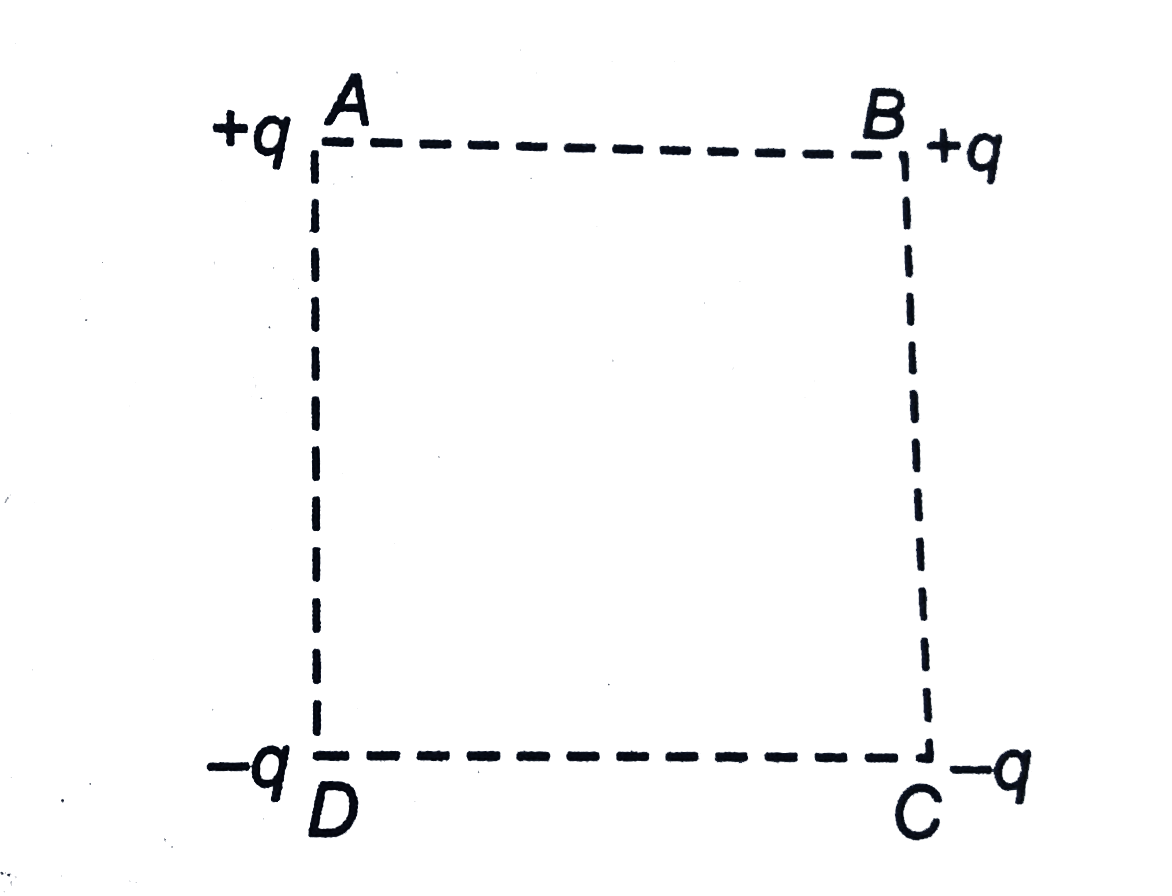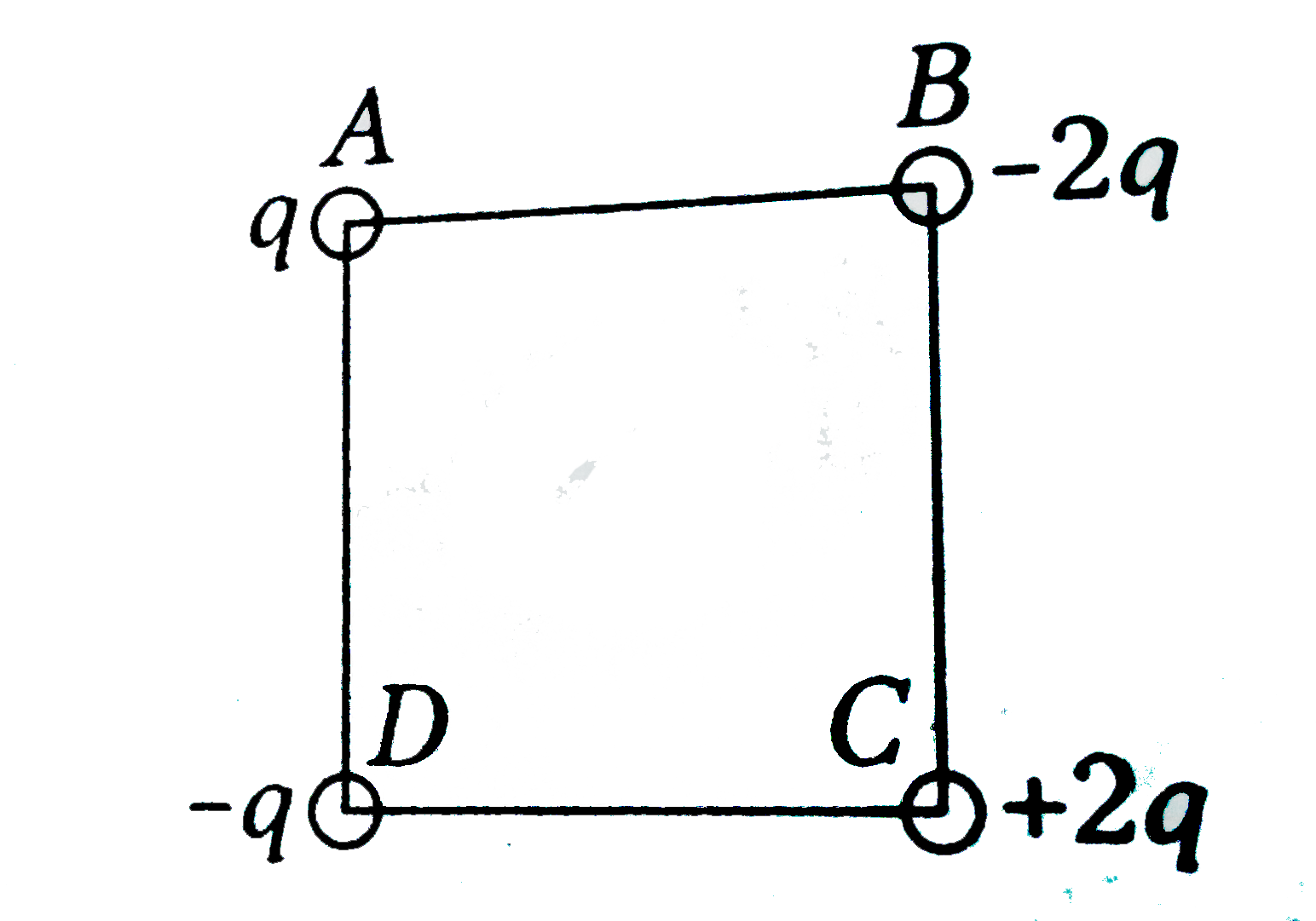Four idenbtial charges +50μC each are placed, one at each corner of a square of side 2m. How much external energy is required to bring another charge of +50μC from infinity to the centre of the square
(Given 14πε0=9×109Nm2C2)
64 J
41 J
16 J
10 J
The correct Answer is:A
To solve the problem of how much external energy is required to bring another charge of +50μC from infinity to the center of a square with four identical charges of +50μC each placed at its corners, we can follow these steps:
Step 1: Determine the distance from the center to a corner of the square.
The side length of the square is given as 2m. The distance from the center of the square to any corner can be found using the Pythagorean theorem. The distance r from the center to a corner is given by:
r=√22×side length=√22×2=√2m
Step 2: Calculate the potential at the center due to the four charges.
The electric potential V at a point due to a point charge is given by:
V=kQr
where k=14πϵ0=9×109Nm2/C2, Q is the charge, and r is the distance from the charge to the point.
Since there are four identical charges Q=50μC=50×10−6C at the corners, the total potential VO at the center O is:
VO=4×kQr
Substituting the values:
VO=4×9×109×50×10−6√2
Step 3: Calculate the work done in bringing the charge from infinity to the center.
The work done W in bringing a charge q from infinity to a point where the potential is V is given by:
W=qV
Here, q=50μC=50×10−6C. Thus, substituting the expression for VO:
W=50×10−6×VO
Substituting VO from Step 2:
W=50×10−6×(4×9×109×50×10−6√2)
Step 4: Simplify and calculate the final value.
Now we can simplify the expression:
W=50×10−6×4×9×109×50×10−6√2
Calculating the numerical values:
1. 50×50=2500
2. 4×9=36
3. Thus, W=36×2500×10−12×109√2
4. =90000×10−3√2
5. =900001.414≈63660.2J
So, rounding off, we get:
W≈64J
Final Answer:
The external energy required to bring the charge from infinity to the center of the square is approximately 64J.
---
The side length of the square is given as 2m. The distance from the center of the square to any corner can be found using the Pythagorean theorem. The distance r from the center to a corner is given by:
The electric potential V at a point due to a point charge is given by:
The work done W in bringing a charge q from infinity to a point where the potential is V is given by:
Now we can simplify the expression:
2. 4×9=36
3. Thus, W=36×2500×10−12×109√2
4. =90000×10−3√2
5. =900001.414≈63660.2J
The external energy required to bring the charge from infinity to the center of the square is approximately 64J.
Topper's Solved these Questions
- ELECTROSTATIC POTENTIAL AND CAPACITORSBOOK - DC PANDEY ENGLISHCHAPTER - ELECTROSTATIC POTENTIAL AND CAPACITORSEXERCISE - (B) Chapter exercises
17 Videos
- ELECTROSTATIC POTENTIAL AND CAPACITORSBOOK - DC PANDEY ENGLISHCHAPTER - ELECTROSTATIC POTENTIAL AND CAPACITORSEXERCISE - (C) Chapter exercises
50 Videos
- ELECTROSTATIC POTENTIAL AND CAPACITORSBOOK - DC PANDEY ENGLISHCHAPTER - ELECTROSTATIC POTENTIAL AND CAPACITORSEXERCISE - Check point 2.5
20 Videos
- ELECTROMAGNETIC WAVESBOOK - DC PANDEY ENGLISHCHAPTER - ELECTROMAGNETIC WAVESEXERCISE - Sec C
22 Videos
- ELECTROSTATICSBOOK - DC PANDEY ENGLISHCHAPTER - ELECTROSTATICSEXERCISE - Medical entrances gallery
37 Videos
Similar Questions
For charges A,B,C and D are plasced at the four corners of a squre of a side a. The energy required to take the charges C and D to infinity (they are also infinitely separated from each other )is

View SolutionThe electric field due to a charge at a distance of 3 m from it is 500NC−1. The magnitude of the charge is
[14πε0=9×109N−m2/C2]
View Solution
Knowledge Check
Four equal charges Q are placed at the four corners of a square of each side is 'a'. Work done in removing a charge −Q from its centre to infinity is
AzeroB√2q2πε0aC√2qπε0aDq2πε0a
Four charge are placed at the corners of a square of side 10 cm as shown in figure having. If q is 1μC, then what will be electric field intensity at the centre of the square?

View SolutionThree particles, each having a charge of 10μC are placed at the coners of an equilateral triangle of side 10cm. The electrostatic potential energy of the system is (Given 14πε0=9×109N−m2/C2)
View SolutionTwo point charges 100μC and 5μC are placed at points AandB respectively with AB=40cm. The work done by external froce in displacing the charge 5μC from B to C, where BC=30cm, angle ABC=π2 and 14πε0=9×109Nm2/C2
View SolutionA charge of 5μC is placed at the center of a square ABCD of side 10cm. Find the work done (inμJ) in moving a charge of 1μC from A to B.
View SolutionElectric charges of +10μC,+5μC,−3μCand+8μC are placed at the corners of a square of side √2 m, the potential at the centre of the square is
View SolutionTwo charges of 4μC each are placed at the corners A and B of an equilaternal triangle of side length 0.2m in air. The
electric potential at C is [14πε0=9×109N−m2C2]
View SolutionCharges of +103×10−9C are placed at each of the four corners of a square of side 8cm. The potential at the intersection of the diagonals is
View Solution
